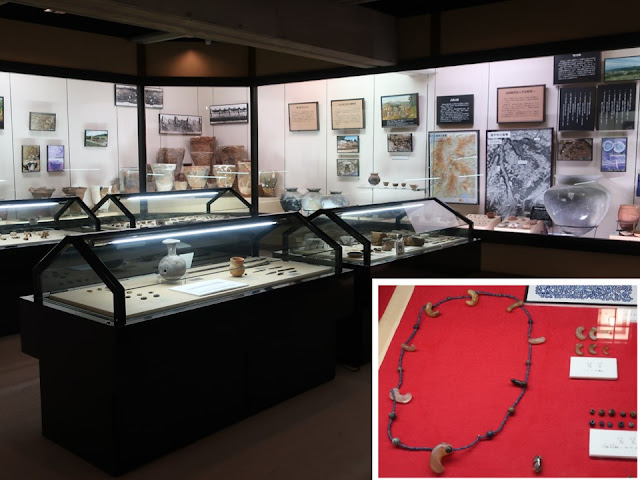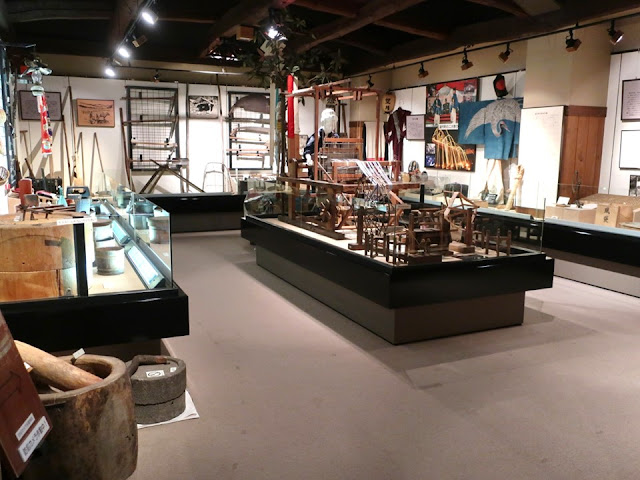Mochizuki was a post-town of Nakasendou highway, which linked Edo (old name of Tokyo) and Kyoto. It was a lively town where a professional sumo wrestling tour and so on were held. I uploaded photos under the approval of the city office.
望月は、長野県・佐久市にある中山道の宿場町でした。町では、大相撲の巡業も開かれました。宿場は賑やかですね。写真は、許可を得て掲載しました。
There is a stone with a hole at the entrance, which was used to hitch a horse or a cow. The width of the highway in Mochizuki was 9 meters. There was a waterway in center, and horses drank the water. We can imagine old days easily.
玄関横にあるのは、牛や馬をつなぐために使った「駒つなぎ石」です。江戸時代の望月宿の道幅は9m(5間)、道の真ん中に水路があり、馬の飲水などとして利用していました。昔の様子が目に浮かびますね。
The first exhibition room (local history and culture)、第一展示室(郷土の歴史と文化)
Historical objects until the medieval era are exhibited. The necklace which was excavated from Otsuka tumulus (lower right). It has a big comma-shaped-bead (magatama).
戦国時代までの品々が展示されています。大塚古墳から出土したネックレス(右下)には、大型の勾玉が付けられていますよ。
The second exhibition room (Nakasendou highway and Mochizuki post-town)、第二展示室(中山道 望月宿)
I’d like to upload the photo of entrance only, because most of exhibits are prohibited to take photos. The exhibits of the post-town guards and the mountain worship (Shugen-dou) are impressive.
Guards' equipment such as jitte (short metal truncheon) are exhibited. Their status was lower than ordinary people (farmers or towners). However, they acquired martial arts and fulfilled their duty.
There was a temple which belonged to a mountain worship sect. I was surprised that the worship penetrated even in the rural post-town; I knew how worship was essential for people.
ほとんどの展示品が撮影禁止なので、入口のみを紹介します。古文書の展示が中心ですが、宿場の警備などを担った長吏(ちょうり)職と修験道の展示が印象的でした。
長吏職は、百姓町人より低い身分とされていましたが武術を習い職責を果たしました。彼らが使った十手などが展示されています。
また、望月には、修験道の当山派修験寺・大応院(本山は醍醐寺三宝院)が、かつてあったそうです。街道筋にも修験道が浸透していたのでビックリしました。生活の中で、いかに、信仰が大切だったかが分かります。
The third exhibition room (People’s life and tradition)、第三展示室(人々のくらしと伝統)
I had a feeling that I could find “Fun of good old Japanese”, which is the theme of this blog, in the room. But, before I went into the room, the showcase about sumo wrestling on the right, attracted me.
本ブログのテーマである昔の人たちの楽しみが見つかりそうな展示室です。でもその前に、右側にある相撲についての展示ケースに引っ張られました。
The wooden board on the top shelf shows the ranking list of the tour. The paper at the bottom shelf shows a menu for Futabayama (1912-1968), who was a legendary sumo champion. 900 grams of rice were cooked for him a day; it was four times as much as the amount for ordinary people. Egg, carp, chicken, loach and so on were cooked for him. Egg was a precious ingredient back then; people ate it during illness. Egg was served at every meal for him.
最上段は「相撲巡業番付」、最下段が「双葉山関献立表」(右)と「双葉山関若者献立表」(左)です。双葉山関には、一日で六合、夕食では玉子、鯉、野菜、かしわ、柳川料理が出されました。当時は病気の時に食べる貴重品であった玉子は毎食出されています。
In the room, many exhibits surround the weaving machine in center.
展示室の中には、機織り機を中央にして、ずらりと展示品が並びます。
The exhibits such as sake (alcohol) bottles are preserved in good condition. Bottles were returnable in the old time; it’s a sustainable style.
ビンボートックリなどの酒器、保管状態がいいです。酒も醤油もリターナブル瓶でした。サステイナブルですね。
Footwear is also well preserved. The shoe straps for female are adorable. I wonder if they walked even on icy road with the shoes.
履物も状態が良いです。女性用の下駄の鼻緒は可愛らしいデザイン。凍った道や雪道もこれで歩いたのでしょうか。
Farm implements are exhibited with photos. The bar was used to thresh beans, buckwheat and so on; they hit crop. A child (granddaughter?) watched the work. It’s a quality time.
農耕の道具です。「叩き棒」は、豆や蕎麦の実を取り出すためのものです。子どもが祖父?の仕事ぶりをじっと見ています。子どもの前で働けるなんて嬉しいことですね。
Various implements for forestry (left), quarry (center) and ginseng cultivation (right) are displayed.
After a harvesting season, men worked at mountains to make charcoal, firewood and so on. They also cultivated ginseng, which is a local specialty even until now. Women made pickles, clothes and so on.
左側が山仕事の道具、右が採石と薬用人参作りの道具です。
刈り入れが終わると、男性は山仕事(炭焼きや薪作り)や特産の薬用人参の作りに藁仕事、女性は漬物を漬けたり衣服を作ったりしました。
The standing item is a gun made by straw. Children hit ground to drive away bad things at the harvesting festival on 10th of October in lunar calendar. It’s a very rustic event.
立てられているのは、十日夜(とうかんや)の藁鉄砲です。旧暦10月10日の収穫祭で子供が藁鉄砲で地面を叩いてあるきます。素朴な行事ですね。
In a section of festivals, two major festivals in Mochizuki are introduced. One of them is “Sanbasou”, which is the dance praying for fortune. It is performed in a spring festival. The other one is “Sakaki festival”. It is held on the 15th of August. Several hundreds of people, who bring torches, down from a mountain. They throw the torches to the river in order to purify bad things and to pray for rich crops and sound health. (I refrain upload the photo because personal properties are included.)
祭りのコーナーもあります。4月3日の初祭りで奉納される三番叟と、8月15日の榊祭りの松明投下が望月の二大ハイライトです。榊祭りでは、数百人が松明をかざして山から下り、鹿曲川に投げ入れ、不浄を浄め、五穀豊穣・無病息災を祈ります。(寄託品が含まれるため写真は割愛します)
Old pictures are displayed at the hallway.
廊下に昔の写真が展示されていました。
The photo above is a sumo wrestling match in the early 20th century. The judges sit down by the ring (they sit down at the front seats of spectators' ones at present). The position is same as the printing (ukiyoe) in the Edo period (1603~1868). It is a popular event.
昭和初期の相撲大会。審判が土俵で座っていて、江戸時代の浮世絵(右上、勧進大相撲繁栄之図 https://dl.ndl.go.jp/info:ndljp/pid/1307335)のようです。賑わっていますね。
Ebisu-kou event was held on the 18th of November; it is after a harvest season and is a beginning of winter. A big sale was held during the event. The photo was taken in 1931.
刈り取りが終わった11月18日に行われる「えびす講」は冬の始まりでもあったそうです。信州では、えびす講の時に、大売り出しがあります。昭和6年の写真。
Mochizuki post-town、望月宿
The large old building (waki-honjin) on the right side was an inn for upper-class travelers such as a lord.
右側の立派な建物は脇本陣。今も住居です。ちなみに、本陣跡地には、病院が建っています。
The signboard (lower left) of geta (Japanese clogs) is famous. It was a shoe store.
有名なのは、かつての下駄屋さんの「香美屋」。今も軒先に下駄の看板が吊されています。
Shionada post-town、塩名田宿
The town prospered at around 1900. Silk mills (factories), banks and so on were built; the entertainment district was also built. However, at around 1940, the sound of shamisen (Japanese guitar which are played by geisha girls) disappeared. The entertainment district reflects the wealth of the town.
町が活気を帯びたのは明治30年代。製糸工場や銀行などができ、花街になりました。でも、昭和10年代になると三味線の音が消えていったそうです。花街は敏感ですね。
Odai post-town、小田井宿
Women and children were major guests of inns here. Because, there were not ladies who entertain guests although its neighboring Oiwake post-town had lots of such ones. The guidebook in the Edo period (1603~1868) says, “There are many farmhouses, but are a little inns”. There is a very fine line between prosperity and depravity, I think. The house on the right was an inn (honjin) for daimyo lords. It is not open to the public.
東隣りの追分宿と異なり、飯盛り女がいなくて、婦女子の宿泊が多かったそうです。でも、木曽路名所図会に「多く農家にして、旅舎少なし」と書かれています。繁栄と堕落、紙一重ですね。右側が旧本陣の安川家(非公開)です。
Reference and former article about Nakasendou highway: Karuizawa Oiwakejuku Museum of Local History、軽井沢町追分宿郷土館
The residence is well-kept and is beautiful.
今も手入れが行き届いた美しい住宅です。
Visited in June, 2023
Official
website: https://www.city.saku.nagano.jp/shisetsu/sakubun/rekishishiryokan/index.html
(in Japanese), accessed in December, 2023
Previous post (museum in Wakayama prefecture, western Japan): Kainan
history and folklore museum、海南歴史民俗資料館
Next post (museums of the nearby post-town): Nagakubo post-town and museums、長久保宿と資料館





















Comments
Post a Comment